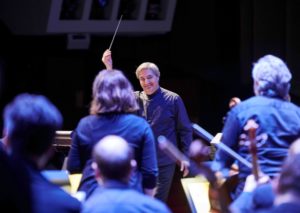
Orchestras are always looking for ways to broaden their audience and engage more deeply with them. Many orchestras cite an aging audience and the move away from specialized music education in schools as reasons for a slow but steady decline in audience sizes. In recent years, however, there has also been a trend for orchestras to want to make up for this gap in specialized music education and to appeal to a younger new audience, while fostering a deeper engagement with their current patrons. This is done in a variety of ways from pre-concert talks to ‘Symphony 101’ type guides. In the Winnipeg Symphony Orchestra’s case? They went digital.
To elaborate, the WSO is making use of a companion app called EnCue at three of their concerts this year, with the intention of integrating this app into more concerts in coming seasons. EnCue is a free-to-download app that sends users live, real-time program notes, images and stories during the performance. The EnCue website lists the app at $350 USD per concert, with potential discounts for multiple concerts. The WSO launched the app at their October 18th (B)eyond Classics series concert, for the performance of Sergei Rachmaninov’s Symphonic Dances. Though app-users weren’t separated from the rest of the audience, the screen is dark lit and the hall lights are brought up to avoid disturbing other patrons. This is the first example of something like this being done in Canada, though several orchestras in Europe and the United States have integrated similar technology into their concert programs. Advertising for the concert mentioned EnCue as a point of interest for prospective patrons.

For Jean-François Phaneuf, VP Artistic Operations at the WSO, the benefits of the app are twofold. “We’re excited about using this app to appeal to new audiences and increase the level of engagement with current and prospective patrons. We saw some audience members who were deeply moved by the experience. You get to read about Rachmaninov’s thoughts when writing his work and Music Director Daniel Raiskin’s personal connection to a special passage while hearing it all unfold on stage in front of you.” Over the course of two months, Jean-François Phaneuf, James Manishen, Artistic Associate and RBC Assistant Conductor Naomi Woo worked hard to prepare the necessary materials. They tested their content among musically-educated and non-musically-educated WSO staff, and found that short slides (5 seconds to read) and images helped to keep people listening actively. The learning curve for programming the app was steep, but with satisfying results; basic concepts were explained for those unfamiliar to orchestral music, and more complex ‘tidbits’ of information were provided for experts. During the concert, Naomi Woo was backstage with the score, synchronizing the slides with the music for the approximately 200 patrons that downloaded the app. The response from app users was generally positive. By and large, patrons were excited to try something new. Some concertgoers expressed resistance to changes to the concert experience they know and love, but many felt a greater understanding of, and deeper connection with the music through the new information they were given.
There is no intention from the WSO to use EnCue at all of their concerts. It is planned only three times this season for one piece per program. WSO audiences will next see EnCue at the closing concert of the New Music Festival in January, for Michael Daugherty’s Metropolis Symphony and during Shostakovich’s Symphony No. 6 in March. There are plans to integrate EnCue into the second half of every concert for their (B)eyond Classics concert series in 2020-21. With a tech help desk in the lobby at the October 18th concert, most technical challenges were avoided. More studious patrons also requested receiving the slides in advance to ‘study up’ for the concert. Both the WSO and Orchestras Canada are excited about the opportunities presented by giving a wider audience more ways to open the door and access orchestral music in a way that enhances what is presented on stage.
Learn more about the question of digital technology in the orchestral industry by reading our interview with The Space’s Fiona Morris on building a digital organization.
